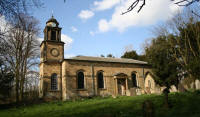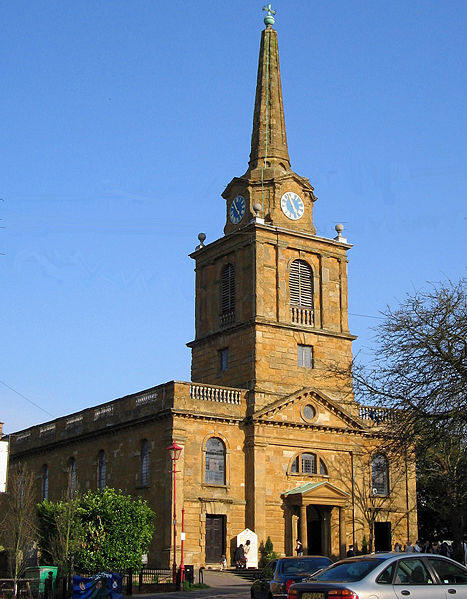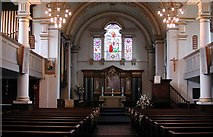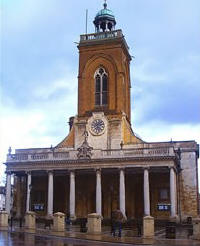
|
|
|
You will then need to navigate back to this page using the County Index |
|
Churches which still retain west gallery features or connections |
|
| Alderton, Dedication not known |
The west gallery incorporates
Perpendicular style bench fronts and backs. A
painted
inscription on west gallery reads:
“This
Gallery Was Erected For The Singers Only |
| Aynho, St Michael |
"The church still has a rich 15th
C. tower, but the bulk of the building was transformed in 1723-5, after the
manner of Vanburgh, by a local carpenter-cum-architect, Edward Wing. His
alterations are uncompromisingly domestic in style with windows in two storeys,
and illustrate one of the phases of history of English churches which the
Victorians tried to pretend had never existed." (R
Stanley-Morgan ARIBA and Gyles Isham in 1958 in CEPC) The west gallery and handsome box-pews survive, with a fine wooden lectern, candleholders and painted organ pipes. |
| Cottesbrooke, All Saints | A secluded church set in a churchyard full of Irish yew trees, and contains an extraordinary 17th C. pew, in two storeys with fireplace, built for the Langham family, and a three-decker pulpit . There are also box-pews in the nave. (CEPC) |
| Crick, St Margaret of Antioch |
SP588725.
Organ by Thomas Elliot,
London, 1819, for St. James Chapel Royal, London,
installed 1841 in west gallery (N17898),
moved to Milverton (Leamington) in 1837 (see D01977),
when "addition of Pedal Pipes and other
improvements" is noted by "A.B.C.," in
Musical World vol. 4, 1837; moved here;
an inscription says: "John Clarke, a native of
this parish, desirous to
promote the due performance of that part of Divine
Service which celebrates the
praises of Almighty God, Presented this organ for the
use of the Parish Church. -
Crick, Oct 14th, 1841."
Mr Clarke, who was blind, used himself to play the organ, and he provided for an endowment to pay his successor. The case retains the Royal Arms; the unusual round towers at the front corners were probably added when the organ left the Chapel Royal. The G compass was still to be seen in 1924, and I fancy also 20 years later.) ( BBE). (Restored shortly after BBE's visit in 1974). [Notes taken from The National Pipe Organ Register]
|
| Daventry, Holy Cross |
A typical 18th C. church by David
Hiorn of Warwick, after models provided by the works of
Flitcroft and Gibbs in
London and Derby. There is a gallery in each aisle supported on Tuscan columns.
(CEPC)The building consists
of nave, chancel, north and south aisles with galleries on
three sides. There were originally three entrances to the
church, one leading to the nave and the outer ones via stairs
to the galleries.
The pulpit and two
clergy stalls are believed to date from 1752,
the date of the church itself. (Church website).
This image has been (or is hereby) released into the public domain by its author, G-Man at the wikipedia project. This applies worldwide. Original at: http://commons.wikimedia.org/wiki/Image:Holy_Cross_Church,_Daventry.jpg#file
Holy Cross, Daventry, Northants - East end |
| East Carlton, St Peter | Classic features including box-pews. (CEPC) |
| Easton Neston, St Mary the Virgin | The church contains fittings and monuments of a classical character, together with box-pews and hatchments. |
| Gretton, St James the Great | "Box-pews and pulpit, etc.; good seating". (CEPC) |
| *Harlestone, Dedication not known | Late 17th C. west gallery; "Fat vertically symmetrical balusters". Gallery very narrow and set very high - possibly simply for access to ringing chamber. (Guidebook) |
| Marston Trussell, St Nicholas | The church is said to have an 18th C. pulpit and other fittings, but further details not known. |
| Northampton, St All Saints |
The church was built in 1863-64,
mainly in sandstone. Along with the church, a large parsonage
and a church school were built at the sole cost (some £10,000)
of William Windley JP, a local philanthropist. The church was
built in
Gothic revival style to seat 500, and has a fine broach
spire reaching 175ft tall (8th tallest building in
Nottingham) and housing a ring of ten bells (the heaviest
weighing 16cwt).
Galleries
to north and south. |
| Ossington, Church of the Holy Rood |
 Photo: Richard Croft, Wikipedia, Creative Commons Lience The church was medieval but completely rebuilt in 1782 to 1783 by John Carr of York. It has a barrel organ by Robson dating from around 1830. It has been awarded a Historic Organ Certificate by the British Institute of Organ Studies which has awarded it a Grade I listing. Details of the organ can be found on the National Pipe Organ Register. |
| Overstone, St Nicholas | Neat Gothic church of George III's reign with box-pews. (CEPC) |
| Passenham, St Guthlac | Carolean chancel richly fitted out, stalls with miserecords and traces of 17th C. paintings. Furnishings circa 1626-8. Gallery once part of chancel screen; in 1712 referred to as the "Wainscoted Partition betwixt the Chancel and Body of the Church." |
| Stanford-on-Avon, St Nicholas | The nave has been cleared of pews, and there are several hatchments. The best features of the church are its west gallery and 17th C. organ case. Archbishop Laud was once Rector here. The gallery carries the organ. |
| Steane, St Peter | A tiny 17th C. chapel set in the Great Park, built in 1620 by Sir Thomas Crewe. Services held but once or twice a year, as the nearest Village, Hinton-in-the-Hedges, has its own church. Box-pews, two-decker pulpit. |
| Stoke Doyle, St Rumbald | A "rustic Georgian church" which retains its pulpit, pews and font from the 18th century. It retains that atmosphere, but further details of the fittings are not known. |
| Tichmarsh, St Mary the Virgin | Above the arch can be found the Pickering family pew, constructed in the 17th century. |
| Wollaston, Dedication not known | Nave and furnishings, including the west gallery, date from 1737. |
|
Churches which are known to have had west gallery features or connections |
|
| Kings Sutton, St Peter and St Paul | Richly ornamented steeple rising 100ft above the flying buttresses at its base, and 198ft above ground level, this church is visible from the nearby M40. Once contained a west gallery, removed 1840. |
| Stowe-Nine-Churches, St Peter & St Paul | The church is of many periods, from Saxon onwards. Its west gallery and other fittings of the same period were removed during the "restoration" of 1859. |
|
Chapels which have or had west gallery features or connections |
|
| Brackley St Peter, Congregational (now URC), Banbury Road, Brackley |
SP 582369. Coursed rubble
and slate, built 1836 for a newly formed congregation. The
front is of three bays with pilasters of a lighter coloured
stone. In the central gable is a tablet inscribed
'INDEPENDENT CHAPEL 1836'.
The interior was partly refitted in the late 19th century, but the original pulpit remains in the schoolroom at the rear. There are no public galleries, but above the entrance lobby is a singers' gallery with staircase, seating and precentor's rostrum of ca. 1836. (C&MH-N&O 1986) |
| Brackley, Former Wesleyan | SP 585371. Built 1816, superseded in 1905. Coursed rubble and hipped slate roof. Gallery around three sides, rounded to rear. Demolished ca. 1980. (C&MH-N&O 1986) |
| Braunceston, Wesleyan | SP 540661. Stone with brick dressings; gabled north front dated 1797, rendered 1875, with wide doorway, two tiers of sash windows and circular window in the gable. The side walls each have two lower windows and one between at a higher level. The interior (32ft x 31ft) has an early 19th century gallery around three sides with panelled front supported by timber columns and retaining contemporary box-pews. Other seating is late 19th century. (C&MH-N&O 1986) |
| Bugbrooke, Baptist, High Street | SP 677573. Coursed rubble with ashlar west front and hipped slate roof. Dated 1808. Organ chamber built 1885. The interior has original west gallery only, with panelled front; the seating and pulpit are of the late 19th century. (C&MH-N&O 1986) |
| Burton Latimer, Baptist, Meeting Lane | SP 902749. It was erected 1744, extended to the rear 1832, and altered and refitted in 1878, 1889, and later. Walls of coursed brown ironstone and a roof of stone slates. The interior has a gallery on all four sides. (C&MH-N&O 1986) |
| Clipstone, Baptist, | SP 709819. Brick and slate, built 1803 to replace a chapel of 1777, but with rendered pedimented front added ca. 1864. Gallery round three sides, original date-tablet of 1803 re-set at foot of stairs. (C&MH-N&O 1986) |
| Corby, Former Congregational, Meeting Lane | SP 896890. Small chapel of rubble with a hipped slate roof; soon after 1834 the walls were heightened, a gallery inserted and the interior refitted. (C&MH-N&O 1986) |
| Creaton, Congregational, High Street | SP 707719. The meeting-house, seating some 400 people, was erected ca. 1694, although the present building dates from c. 1794., enlarged in the early 19th century to the rear. The interior has a gallery in the west extension. The pulpit, re-sited on a later rostrum at the east end, is of the early 19th century, other fittings later. (C&MH-N&O 1986) |
| Daventry, Congregational, Sheaf Street |
SP 572624. Formerly
Presbyterian, now URC. Originally the Presbyterian
congregation purchased a single house in 1722 and built the
present meeting-house behind it. The houses, of three
stories with brick walls and tiled roofs, were built ca.
1752; they have a three-centred arched opening leading to
the rear over which a tablet placed in 1864 records
"Independent Chapel Erected AD 1722." One
house served as a residence for the minister, the other was
used from 1752-89 by the dissenting academy formerly held in
Northampton to which it subsequently returned.
The interior has two timber posts, supporting a valley-beam parallel to the front, of circular section with octagonal bases and moulded capitals. The gallery around three sides was largely reconstructed in the late 19th century when a major refit took place; a seating plan of 1775 indicates a single gallery at the south-west end, side galleries being added ca. 1820. (C&MH-N&O 1986) |
|
Flore, Congregational, Chapel Lane |
SP646600. The present chapel. erected in 1880, stands close by its predecessor, now the Sunday-school, built in 1810 as a preaching station for Weedon Bec. The former chapel, of brick and slate, has a gabled west front with round-arched doorway, fanlight and semi-circular canopy; two lunettes light the back of the gallery. (C&MH-N&O 1986) |
| Irthlingborough, Baptist, Meeting Lane | SP 949708. Built in 1713 for a society which was reorganized as a Strict Baptist church in 1794. Galleries were added to the building in 1794. The rear wall has two round-arched pulpit windows and smaller windows at the gallery ends. The interior has a gallery round three sides; the pulpit was replaced by a rostrum c. 1884. (C&MH-N&O 1986) |
|
Kilsby, Congregational, Chapel Street |
SP 562709. Encouraged by ministers ejected from Kilsby and Crick, a house was fitted up for meetings, and galleries were added to it in 1750 and 1755. This was superseded by the present building in 1763. This has a single gallery opposite the pulpit with panelled front divided by narrow pilasters and supported by three oak columns with moulded capitals and high attic bases. (C&MH-N&O 1986) |
| Kislingbury, Baptist, Mill Road | SP 695594. Squared rubble and slate; gabled front with chamfered plinth, central entrance with flat canopy between two tiers of flat-arched windows, and tablet in gable with moulded cornice and date 1828. Gallery at front end only. Refitted 1875. (C&MH-N&O 1986) |
| Long Buckby, Congregational, Brington Road | SP 629674. Chapel was built in 1771, and replaces a previous small meeting-house which was sited nearby. Enlarged to the rear in 1819, altered internally in 1859 and fittings further modified in 1899 and 1951. The interior has a gallery around three sides and a pulpit of 1859 at the south end. The 1819 enlargement provided a further south gallery behind the site of the former pulpit which was removed in 1859 but the two substantial wooden columns which supported it at each end remain below the side galleries. (C&MH-N&O 1986) |
| Milton Malsor, Baptist | SP 734555. Wide three-bay front with central doorway and small upper windows; tablet below centre window dated 1827. Front gallery added ca. 1871 and reseated in 1876, but still with box-pews; rebuilt pulpit incorporates original material. (C&MH-N&O 1986) |
| Northampton, Castle Hill Meeting-House, |
SP 750606.
Congregation originally included both Presbyterian and
Independent elements, although latterly Congregational (now
URC). The original meeting-house of 1695, much altered and
enlarged to the north in 1862, forms the basis of the present
building. The interior has side and rear galleries of 1852,
extended 1862, and contemporary box-pews. Former galley
clock now in west vestry. The original pulpit now removed to
the Congregational Chapel at Middleton, Wirksworth,
Derbyshire. (C&MH-N&O
1986)
See: Deacon, M; Philip Doddridge of Northampton (1980); Godfrey, B S; Castle Hill Meeting (1947). |
| Potterspury, Congregational | SP 762434. The church, now URC, originated in the late 17th century. Built 1780, there was a house for the minister alongside and in 1846 Sunday-school rooms were added at the west end. Of red brick, with blue headers on the front elevation, rubble at the back, and under a tiled roof. The south front originally had two entrances with two windows between and three above. Stairs in the entrance porch lead to the west gallery; pulpit formerly sited on the north wall, then moved in mid 19th century to the east end. It incorporates the old 18th century pulpit front with fluted angle panels, moulded dentil cornice and shaped back-board. |
| Roade, Baptist |
SP
759517. This chapel was built in 1736-37 for a church formed
ca. 1688. Some alterations were made in the late 18th
century and again in 1802, when a major reconstruction seems
to have taken place, including heightening, re-roofing and
renewal of the window heads.. Built of coursed rubble with
Ashlar quoins under a slated roof.
There is a north gallery only, date unknown. The pulpit and seating date from the late 19th century. |
|
Rothwell, Congregational |
SP
814809. The church, now URC, was formed in 1655, and a
covenant was signed by the members in that year. The present
chapel was opened on 9th November 1735, ut has been much
altered and refitted. A vestry was added in 1762,
schoolrooms built between the front entrances in 1826, and
in 1852 porches with gallery staircases were added. Further
work was carried out in 1893. Built of coursed ironstone
rubble under a slated roof.
The interior, roughly 52 ft x 40 ft, has galleries on three sides, together with box-pews. Prior to 1893 the projection behind the pulpit at the west end was filled with steeply raked choir seating, and had a small organ against the east wall. |
| Rushden, Baptist | SP 960663. The meeting house was described in 1768 as a converted tenement, and seems to have stood on the present site in Little Street behind other buildings. The existing structure is a rebuilding of a 1796 building, with rubble walls and a steeply pitched hipped and tiled roof, possibly originally thatched. Schoolrooms and a vestry added in 1860, and in 1873-4 the chapel was enlarged to the south in yellow brick under a slate roof, gabled at the front. In 1901 a new chapel was opened in Park Road and the Little street building converted for sunday school use. The interior had galleries round three sides and round arched windows either side of the pulpit. |
| Silverstone, Wesleyan | SP 669439. Built 1811 of rubble under a slate roof. Extended to the front ca. 1840. The original datestone is reset in the front wall. The interior was re-pewed in the late 19th century, and the is a gallery ca. 1840 at the front. |
| Slapton, Wesleyan | SP 640468. Of rubble with a red brich front and a slate roof. Tablet on front wall dated 1844. There is a gallery next to the entrance ca. 1844, with coved and panelled front and contemporary open-backed benches. |
| Thrapton, Baptist |
SP999786.
This chapel, which stands back on the north side of
Huntingdon Road, has a brick front and rubble sides. The
rebuilt parapet hides a low roof. Original building from
1787, extended to the north in early 19th century.
The interior, altered in 1885-85, has a gallery round three sides, box-pews and several wall-monuments. The burial ground has several slate headstones. |
|
Walgrave, Baptist |
SP 802721. Originating as a church ca. 1700, by 1763 it is recorded that it met in a converted barn. The present site was acquired in 1786 and the meeting-house erected the same year. Built of rubble walls under a slate roof, the interior was drastically refitted in 1886, when the east and west galleries were removed. The south gallery survives. |
|
Weedon Bec, Congregational |
SP 631592. The church, in Church Street, is now URC. it originated in the late
17th century and by 1688 comprised a joint congregation at Flore and Weedon Bec.
The former was described in 1715 as Independent, but the latter in 1767 was
regarded as Presbyterian; this was also the year in which John Wesley, when
refused the use of the Parish Church, 'accepted the offer of the Prebyterian
meeting-house'.
Rebuilt in 1792, and registered in the following year, is has rubble walls with an ashlar front, and a hipped slate roof with moulded eaves cornice. The east front is dated 1792, and has segmental-arched doorways with altered fanlights and high pedimented canopies. The interior has galleries around three sides, the east gallery being the earliest and the side galleries added in the early 19th century. Clock on front of east gallery, early 19th century. Seating in gallery is early 19th century; box-pews ca. 1850 below. |
| Weldon, Congregational | SP 924897. Meetings originally held in the house of Edward Nutt since 1706 were transferred ca. 1736-38 to a small barn on the present site. This was replaced in 1792 by the existing chapel which was enlarged in 1808 by the addition of a gallery. This is a north gallery, with a fielded panelled front and a wide-boarded floor. One original seat with shaped end remains next to the staircase. |
| Welford, Congregational | SP 640803. The present chapel of 1793 supersedes a building constructed on ground given by the Paynes of Sulby Hall. Walls of red brick, under a hipped and slated roof. The interior was entirely refitted ca. 1891 and has a north-west gallery of this period. |
| Wellingborough, Congregational |
SP 890680. The church (now URC) originated in the late 17th century, following
the ejection of the Vicar, Thomas Andrews, in 1662. It was officially regarded
as Presbyterian. The first meeting-house in Silver Street was superseded in
1746 by a building in Cheese Lane. The present chapel was built in 1875
following the reunion in 1873 of the Cheese Lane church and that meeting at
Salem Chapel, which had seceded from the main body in 1811. [The seceders
objected to the introduction of an organ in the Cheese Lane Chapel.]
This notable and unusual building was designed initially by Caleb Archer, and was completed under the direction of Edward Sharman of Wellingborough. It is ovoid (egg-shaped) in plan, with the pulpit at the narrower end. The principle entrance is opposite in a gabled projection, and further gabled projections at the sides accommodate the gallery staircases. The gallery is semi-circular around the wider end. |
| Wellingborough, Former Congregational, now Methodist |
SP 880678. An Independent congregation formed in the late 17th century and
initially part of the Rothwell church, became autonomous in 1691, in which year
a meeting-house was opened in Crown Yard. This was replaced in 1734 by a
meeting-house in West Street which was rebuilt in its present form in 1791. The
church was disbanded in 1868 and the chapel conveyed to the Primitive
Methodists. It is still in Methodist use [1986[
Of brick under a hipped and slated roof, the west front is of four bays with end entrances, and a tablet dated 1791 in the centre of the four square upper windows. The interior (some 49ft x 40 ft) has been much altered - of the former three galleries only the north gallery remains. |
| Weston, Baptist | SP 589470. The present chapel, registered in July 1791, was for the Baptist congregation which had worshipped in Weston since the early part of the 18th century as part of a church which had embraced several other societies in the vicinity. 'Newly erected' in 1791, the chapel is built of squared stone under a slate roof. The walls appear to have been heightened in the early 19th century and an additional wing was constructed at that period. The interior, about 22 ft x 28 ft, was refitted in the early 19th century, and again later, has galleries on three sides with late 19th century open iron fronts. the north-east gallery is the earliest and has a vaulted ceiling below. |
| Wollaston, Former Congregational | SP 908629. The chapel stands behind houses on the east side of the High Street, and was built in 1752 of rubble walls heightened with brickwork. The original building was lengthened to the south in the late 18th century, incorporating a gallery, and heightened in the mid-19th century. The congregation ceased to meet in the early 20th century, and the chapel has been extensively damaged by fire. (What is its present state?) |
| Woodford cum Membris, Moravian, Parsons Street, Woodford Halse |
SP 544526. The newly established congregation built the chapel in 1798-99,
although it was subsequently altered internally and reorientated in 1828.
Further alterations were carried out in 18 75 when the entrances were removed
to the north-west end. A new chapel was built adjacent to that end in 1906.
The original chapel has brick walls on a stone plinth, and a slate roof. It incorporates a minister's house of two stories at the south-east end. The interior originally had a pulpit against the north-east wall; this was removed to the south-east end in 1828 when the present north-west gallery was erected. The gallery has a slightly projecting centre supported by two octagonal posts. |
| Yardley Hastings, Congregational |
SP 865570. Built in 1813, this chapel replaced an earlier meeting-house of 1718. It is built of rubble walls under a slate roof. The east front has an inscribed band below the pediment with the name YARDLEY CHAPEL on it; between the two smaller and central windows is the inscription Built 1718 The interior is square with the pulpit against the west wall, and between two arched windows. There is a gallery around three sides, supported on cast-iron columns. This has early 19th century pews to the north and south; other seating is of the late 19th century. |
| Yarwell, Wesleyan | TL 069979. Built in 1840, the chapel has a cottage and a Sunday-school attached to it, the latter at the south end. The chapel originally had two doorways in the west wall, now altered to windows. The present south entrance is approached through a passage behind the cottage, in which is a separate doorway leading to a deep south gallery. The interior has been refitted. |
| Asterisks denote churches in preparation | |
|
|



